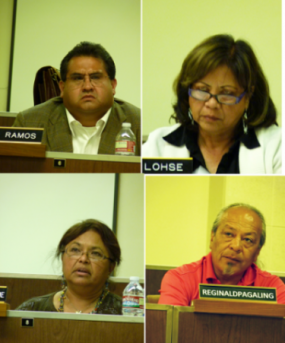
“I really want to say `Dismantle it and give the land back to the tribes…I’d like to ask the Attorney General to…give this commission more teeth so we could say `Tear that wall down.” -- Commissioner Marshall McKay
View video highlights by Paul Kruze: http://youtu.be/nS93BfT6juI
(For full unedited videos, scroll to bottom of this story)
By Miriam Raftery
April 26, 2013 (San Diego) – At a hearing in San Diego on Monday, members of the state Native American Heritage Commission heard several hours of emotional testimony from Native Americans who contend that the U.S. Bureau of Land Management ignored their concerns and its duty to protect a clearly documented sacred site and cemetery in the fast-tracked approval process for the Ocotillo Express Wind Facility.
By a 4-0 vote, with the remaining commissioners absent, the NAHC voted to grant requests by Viejas and Quechan tribes to declare the 12,400 acre Ocotillo wind project site a sanctified Native American sacred site. Further, the commissioners voted unanimously to ask California Attorney General Kamala Harris to research if legal action can be taken.
In addition, commissioners offered to serve as mediators, making clear that they would support the removal of turbines and further, changes to assure that the desecration that happened in Ocotillo will never occur again.
NAHC use of the term Sacred site refers to the formal designation defined under California Public Resources Code 5097.9, which is: “sanctified cemetery, place of worship, religious or ceremonial site, or sacred shrine.” http://www.nahc.ca.gov/cpr.html#5097.9
While nothing can reverse the desecration done to burial sites, removing the 112 turbines each approximately 450 tall would restore views of mountains deemed sacred to the tribes, as well as eliminating flashing lights and noise, restoring a peaceful ambience to the desert site still used for ceremonial purposes including cremations by multiple tribes to this day.
The Bureau of Land Management did not send a representative to the hearing. Commissioner Jill Sherman said she was “deeply disappointed” that the lead agency was not present, adding she would have liked to use stronger language than allowed in the public hearing.
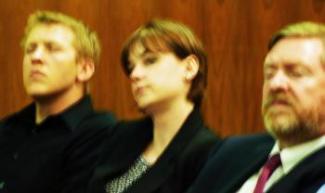 Pattern Energy did send a representative, Natalie McCue (shown in photo, right, in center flanked by other project representatives). She insisted that Pattern has been a “responsible steward” and that effort to respond to tribes’ concerns have been “genuine” as the project moved forward to produce renewable energy. She claimed that Viejas and Quechan never accepted a pre-development meeting invitation and read letters from other local tribes (Campo and Ewiiaapaayp) supportive of the project. (Both have or plan wind development on their own reservations.)
Pattern Energy did send a representative, Natalie McCue (shown in photo, right, in center flanked by other project representatives). She insisted that Pattern has been a “responsible steward” and that effort to respond to tribes’ concerns have been “genuine” as the project moved forward to produce renewable energy. She claimed that Viejas and Quechan never accepted a pre-development meeting invitation and read letters from other local tribes (Campo and Ewiiaapaayp) supportive of the project. (Both have or plan wind development on their own reservations.)
Pattern’s representative said the company did redesign the project to move 37 turbines and stay 600 feet away from known cremation sites. She defended Pattern’s decision not to fund searches by forensic dog teams, which tribes later hired, and rejected the dog findings as “not recognized by the project archaeologist, insisting, “no human remains were found.”
Numerous tribal members and others disputed Pattern’s claims.
“Does economics trump justice in this country? I believe it does and that profoundly saddens me,” Viejas Chairman Anthony Pico told commissioners. “I cannot understand, we cannot understand, how federal and state institutions who have trusted fiduciary responsibility to Native Americans, allowed the utter destruction of arguably the richest cultural resource in our country in Ocotillo Valley.”
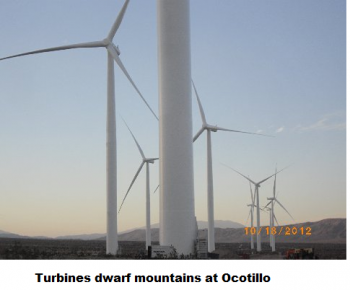 Both Chairman Pico and Quechan President Kenny Escalanti made clear that the tribes do not oppose renewable energy, but only oppose inappropriate siting. The tribal leaders related that the site has been used by tribes for 10,000 years and noted that federal and state laws have recognized the rich architectural treasure trove in Ocotillo and required their protection. Thousands of artifacts were documented long before the wind project was proposed and an ancient spoke wheel geoglyph is listed on the National Register of History Places.
Both Chairman Pico and Quechan President Kenny Escalanti made clear that the tribes do not oppose renewable energy, but only oppose inappropriate siting. The tribal leaders related that the site has been used by tribes for 10,000 years and noted that federal and state laws have recognized the rich architectural treasure trove in Ocotillo and required their protection. Thousands of artifacts were documented long before the wind project was proposed and an ancient spoke wheel geoglyph is listed on the National Register of History Places.
Pico disputed Pattern’s claims and said Viejas did engage in consultation meetings. “No, we didn’t just blow them off.” Pico, Escalanti and others described a pattern of concerns being ignored by Pattern and the BLM. “We told them that total avoidance was the only option. The entire site is one contiguous area,” said Pico, who noted the site is two-thirds the size of Manhattan. He decried seeing turbines “blighting the views of three sacred mountains, Coyote, Signal and Sugarloaf.”
The Viejas Chairman noted that the BLM itself admitted prior to the project that it would ultimately cause traditional uses of property to be desecrated. Agencies at all levels “failed in their duties” to protect the site and further, he called Imperial County’s suggestion that tribes concocted information “insulting.”
 Protecting the geoglyph while allowing it to be surrounded by turbines amounts to “destroying the outside walls of the tomb of Jesus but avoiding the dirt from within,” he added. He also voiced dismay at human remains being removed and transported to a repository in San Bernadino instead of being left onsite or given to tribes for proper handling.
Protecting the geoglyph while allowing it to be surrounded by turbines amounts to “destroying the outside walls of the tomb of Jesus but avoiding the dirt from within,” he added. He also voiced dismay at human remains being removed and transported to a repository in San Bernadino instead of being left onsite or given to tribes for proper handling.
Chairman Pico also questioned how much wind the project is producing and said its necessity was never demonstrated. He then called on the commission to ask that “all turbines be dismantled.”
Quechan President Escalanti noted that the mountains are sacred in tribal creation stories. “Tribal elders refer to this valley as the Valley of Death,” he said. “Ocotillo Wind was constructed on top of the graves of our ancestors.” He called the project approval a “violation of trust to the Quechan people.”
Quechan sued, seeking an injunction to halt the project, but a San Diego Superior Court Judge dismissed the case. Quechan is considering an appeal, Escalanti said, adding that the tribe successfully sued and stopped a solar project in Ocotillo due to sacred sites.
“The federal government ignored our concerns and rushed to approve Pattern’s project,” he said. “Federal laws are not adequate…The laws focus on procedures followed, not on actual harm.”
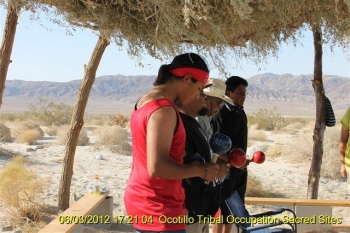 The turbines not only block views and disturb ancestors, but also “impair our ability to use the land for ceremonial purposes,” he added, citing a “tremendous amount of noise” produced by turbines. “The Nevada Supreme Court ruled visual [impacts] and noise from just one wind turbine a nuisance to a community,” he noted. “This is far worse."
The turbines not only block views and disturb ancestors, but also “impair our ability to use the land for ceremonial purposes,” he added, citing a “tremendous amount of noise” produced by turbines. “The Nevada Supreme Court ruled visual [impacts] and noise from just one wind turbine a nuisance to a community,” he noted. “This is far worse."
He added bluntly, “There is no merit to Pattern’s claim that sites were adequately protected.” He denounced removal of “hundreds of artifacts” and disruption caused by turbines, roads and transmission lines.
“The federal government would not stand idly by if Pattern Energy wanted to build wind turbines through Arlington National Cemetery,” Escalanti concluded. “The presence of graves is beyond dispute…Many others remain undiscovered…The only appropriate mitigation is complete cessation of operations and removal of turbines,” he said. “These are incompatible with this sacred landscape.”
Asked by a commissioner if alternative sites were discussed, he replied, “No, they only pushed for this. I even mentioned, `What part of no don’t you understand?’” Escalanti also suggested that some archaeologists and monitors hired by Pattern suppressed evidence out of fear over losing their jobs.
Commissioner Reginald Pagaling made clear that he faults the BLM. “They were the lead agency and although they hired Pattern,” he said, “they had a responsibility here.”
Escalanti replied, “When we tried to tell the BLM to take it elsewhere, it seemed to fall on deaf ears.” He spoke of holding a funeral recently at the site, where lights flashed all night and in the morning, white turbines appeared “like ghosts.” He said the situation was very “sad and disrespectful to all Native Americans” since the BLM is supposed to be a steward of the land. He also faulted then-Interior Secretary Ken Salazar for failing to listen to tribal concerns. “It all boils down to one thing: the almighty dollar.”
Commissioner Jill Sherman said she drives through Ocotillo from Arizona. She called the turbines “looming and scary.” Sherman told tribal members, “I’m very sorry for the destruction of those lands.”
Representatives from several elected officials read letters supportive of the tribes.
“Tribal concerns have not been adequately addressed,” stated a letter from State Senator Joel Anderson. It added that it isi “important not to develop renewable resources to the detriment of Native peoples.”
A letter from Congressman Juan Vargas stated that while he supports renewable, it is very important that projects are “not carved out at the expense of historial and cultural resources.”
Michael Harrison read a letter from Congressman Duncan Hunter, who previously contacted Secretary Salazar to voice concerns about the Ocotillo wind project, as did then-Congressman Bob Filner. Hunter’s letter also raised concerns over “the way projects are fast-tracked in the region” and made clear that the federal government has a “responsibility to respect government to government relations.”
Commissioner Stenslie asked if Rep. Hunter would support dismantling turbines. Harrison said he would ask the Congressman.
Edie Harmon, an Ocotillo resident since 1977, said turbines are rarely spinning. She said the BLM previously denied an open pit mine in another area of Imperial Valley due to sacred lands significant to tribes. Harmon said she was present during consultations on the Imperial Valley Solar project and voiced shock that a BLM official “asked me to sign off that they had met their obligations” regarding consultation despite strong tribal objections to the project. (Quechan later sued and successfully blocked that project.)
Harmon called the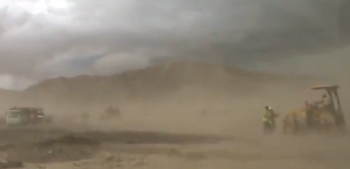 damage “heartbreaking and massive.” She noted that the site was designated as limited use, meaning existing roads could not be widened, yet the BLM allowed 42 new miles of roads to be built. Now there is “terrible dust and sand from roads blowing off site” she added, calling for turbines to be removed and the site reclaimed to the degree that’s possible, in consultation with tribes.
damage “heartbreaking and massive.” She noted that the site was designated as limited use, meaning existing roads could not be widened, yet the BLM allowed 42 new miles of roads to be built. Now there is “terrible dust and sand from roads blowing off site” she added, calling for turbines to be removed and the site reclaimed to the degree that’s possible, in consultation with tribes.
Frank Brown, Chair of the Intertribal Protection Counsel, was a monitor for Viejas on the project. “I was in a BLM meeting and made a comment that was ignored,” he said “In April 2010 I accompanied the coroner from San Diego County to go look at six cremation sites. Five tested positive as humans. “ This, too, was ignored, he said. In one area of the site, over 400 agave roasting pits were recorded but the BLM archaeologist downgraded that to 200. “I believe that was wrong. I went to the archaeologist and said this is a sacred site,” Brown said. “I’ve had BLM staff out, showed them ceremonies. It fell on deaf ears. It was not recorded.”
A representative from Sierra Environmental defended the archaeological work on the project and insisted that there was “excellent tribal representation.”
Preston Arrowweed from Quechan, who is also part Kumeyaay, said the Quechan “still practice cremation today.” He voiced outrage over removal of cremated remains. “When they tell me some white man went over there and picked that up, that’s wrong….There are many, many people out there. It’s up to you, the Commission, to protect us…Man’s greed has changed things.”
Attorney Courtney Coyle, representing Carmen Lucas, advised the commission that the state has the right to enforce the law on federal land. She added that no offsite alternatives were considered and that the BLM was “told to make it happen “ and push through approval.
She gave details of how fast-tracking made stopping the project impossible. “The archaeological tech report was not part of the draft that wente out for public comment. The incomplete environmental document set in place a sequence chain that could not be overcome due to fast-tracking.” Coyle said she asked for more time and her request was denied after she was provided reports on cultural resources the very day of a hearing on the project.
She reserved harsh judgment for Pattern’s claims. “Pattern is entitled to their own opinion, not their own set of facts,” the attorney said. She added, “This the worst politics I’ve ever seen. Many good people were thrown under the bus. Today is Earth Day. Do not allow this process to become a model to be used anywhere else.”
Carmen Lucas, a monitor on the project, spoke out. “There was voluminous prehistory on the ground out there. This process is not correct and I’m saddened.”
 She said forensic dogs have been used on other projects including the UCSD Chancellor’s house in La Jolla. Lucas told of conducting her own test. “My father had me bury an olla with remains of my grandmother, great-grandmother and an ancient medicine man.” Three dogs all alerted with 100% accuracy, she said.
She said forensic dogs have been used on other projects including the UCSD Chancellor’s house in La Jolla. Lucas told of conducting her own test. “My father had me bury an olla with remains of my grandmother, great-grandmother and an ancient medicine man.” Three dogs all alerted with 100% accuracy, she said.
ECM editor Miriam Raftery advised commissioners that ECM has been documenting the Ocotillo situation for the past year and won awards for findings in investigative reports. She confirmed that fast-tracking has ignored concerns of residents, enviornmentalists and seismic experts as well as tribes. Videos and photos by ECM photographers have documented dust storms and flooding of the town with a flammable chemical, yet nothing has been done.
In response to commissioners' question about stage agencies' involvement, she stated tht a whistleblower, former Superintendent of Anza-Borrego Desert State Park, said state park employees were prohibited from submitting negative comments about impacts of the project to the BLM even though the project shares a five-mile border with the park. The BLM delisted the site as critical Bighorn Sheep habitat and despite photos sent by ECM showing Bighorn on the project boundary, Secretary Salazar issued a take permit allowing killing of up to 10 bighorn ewes and lambs. Peninsular Bighorn Sheep are threatened species also viewed as sacred to Native Americans. The Interior Department held listening sessions ostensibily to hear tribal concerns about energy projects on public lands, but held no hearings in the Southwest and failed to record or take notes at a session in Colorado, a local tribal leader told ECM.
Millions of acres of public land are targeted across the nation for wind energy, including McCain Valley in East County, which is on BLM land and is also rich in Native American cultural resources. Viable alternatives in this sunny region, rooftop and parking lot solar, were not allowed to be considered as part of the project's approval process, Raftery observed.
John “Eagle Spirit” Elliott from Manzanita had this to say. “In this great country we have religious freedom…Yet today, Indian freedom is not the same an anyone else’s. We have to document and document, and it’s sad. We can’t let these non-Indian people tell us what’s right in our hearts.” Elliott said that “traditions set forth in ancient times were as strong now as they were then.” He, too, told of many meetings in which the BLM refused to heed tribal concerns, adding that it’s important for the sacred sites used for cremation to be restored. “The most important thing we can do is to send them off to the next world in a good way.”
Commission Chairman James Ramos voiced concern that “this is just the beginning” of such issues since there are many other renewable projects raising controversies in other parts of the state. These include efforts to protect birds sacred to Native Americans.
Chairman Ramos voiced shock that the BLM failed to recognize Ocotillo as a sacred ceemtary. “If the definition `Valley of the Dead’ doesn’t fit that, I don’t know what does.”
He also instructed Pattern’s representatives that “it’s always best to let Native American people have the bones and restore them themselves,” a reference to remains removed to San Bernadino. “What’s lacking here is mutual respect. It’s not just bone fragments…Those are people.”
Commission Leslie Lohse observed, “Here we are again at the point of litigation.” She said the commission has an obligation to consider not only the letter of the law, but also the spirit of the law. While Pattern has a right to pursue green energy opportunities, the federal government years ago accepted responsibility to protect cultural resources and must respect sovereign governments, she made clear. “There is a flawed way of how we approach these projects.”
The commissioner offered some pointed advice to Native Americans present. “Tribes need to go beyond this and carry that process back to [Washington] D..C.” She added, “I have a heavy heart for the tribal people.” Even if wind turbines are taken down, she noted, “where is the justice for what you have been through?” Although remains have been removed and full restoration is impossible, she added, “It has to stop.”
To Pattern, she said pointedly, “I don’t know how you write that there was no significant finding.”
Commissioner Sherman spoke next. “There is no doubt in my mind that this area is sacred. It should have been treated as sacred. This is an immoral project.”
Commissioners attempted to educate Pattern’s representatives on the spiritual significance of an ancient spoke wheel geoglyph on the site that tribes believe marks a corridor to the spirit world for their cremated ancestors.
“There should be no boundaries to a corridor,” Commissioner Reginald Pagoling said. Commissioner Stenslie echoed the thought: “It’s not just the site. It’s the journey to that place.”
Commissioner Pagaling observed,“Other fast-tracked projects are coming. With tribes that do have attorneys here, we need to get on the stick and make changes.” He called it unfortunate that the government requires the commission to deal with the written law, which is inadequate to protect tribal concerns. He then asked Pattern to “have open hearts and listen to Natives here.” Then he assured tribal members present that their complaints to the commission do not fall on deaf ears.
Fast track projects are overlooking “human rights for project rights,” Commissioner Marshall McKay stated. “Projects take precedence over the ability to treat people fairly.”
McKay said that wind is unpredictable and that the wind industry has “far too many false statistics.”
He added bluntly, “I really want to say `Dismantle it and give the land back to the tribes, but I can’t do that. But I’d like to ask the Attorney General to…give this commission more teeth so we could say `Tear that wall down.’” He added, “This will be out goal, that this won’t happen again.”
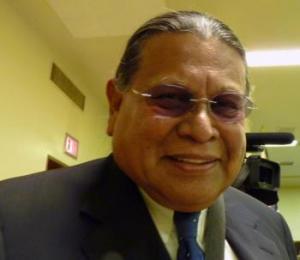 After the hearing, Chairman Pico told ECM he believes the Commission’s decision is “great for Native American cultural resources. The whole area in Ocotillo, Valley of Death, is now labeled as a sacred site. That has legal ramifications,” he said.
After the hearing, Chairman Pico told ECM he believes the Commission’s decision is “great for Native American cultural resources. The whole area in Ocotillo, Valley of Death, is now labeled as a sacred site. That has legal ramifications,” he said.
The Viejas leader hopes to see turbines dismantled, though admits he does not know if that will happen. Although agencies and laws were in place to protect cultural resources, the destruction still occurred. Beyond Ocotillo, his vision is to determine how tribes and work together with federal, state and county leaders to assure that rights will “not be trampled” as future sites are considered for renewable energy.
Chairman Pico sees parallels to challenges faced by Native Americans historically. “I I bet you 150 to 200 years ago, my ancestors were faced with the same questions, and here we go again,” the Viejas leader concluded, calling for more meaningful consultations between the BLM and tribal entities “so that we can make sure this doesn’t happen again.”
View full unedited videos of entire hearing:
http://www.youtube.com/watch?v=TMG0dh5SZFw
http://www.youtube.com/watch?v=dyUA1reh2EA
http://www.youtube.com/watch?v=s6R7Waft1mU







Comments
A more perfect example of
A more perfect example of homegrown ideology would be hard to find. Hundreds of thousands--soon, millions--of unspeakably beautiful wilderness acres, many of them containing priceless archeological and historical artifacts, are currently being obliterated in the name of "green power" sources--in this case, wind and solar--that are both pitifully inadequate to meet even a fraction of our real energy needs, and terribly expensive to produce.
But never mind such realistic objections. Their intentions are good, right?--perfectly in keeping with the requirements the environmental zeitgeist.